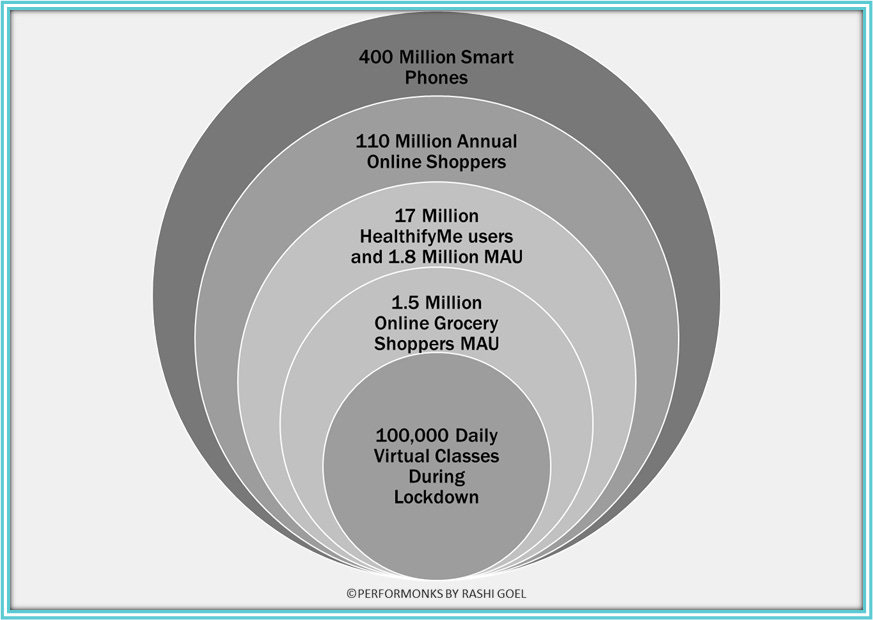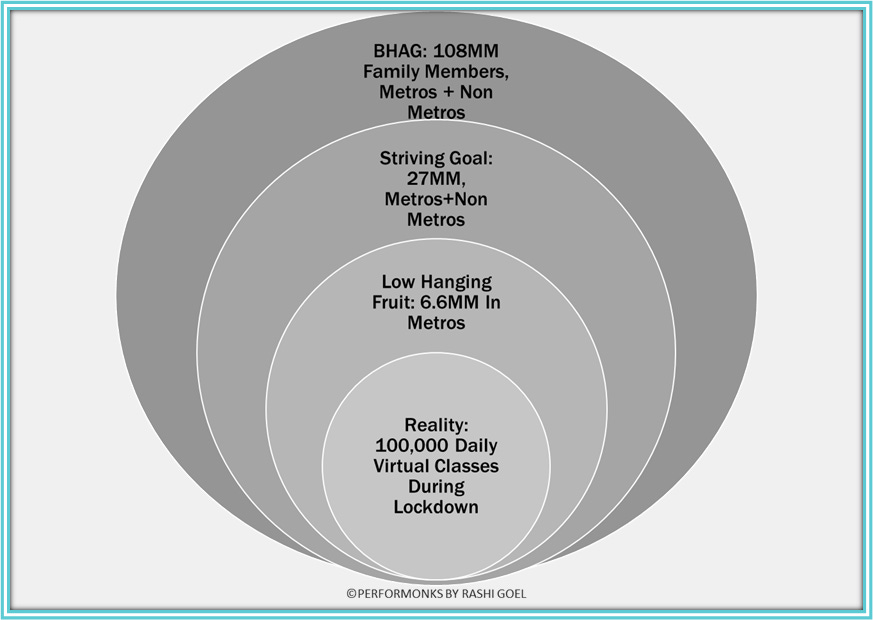#57 01.07.2023
I like to analyse brands and startups that resonate at a personal level in some way. I wrote about Phool and how it could get to a unicorn valuation because I liked their surprising yet obvious-on-hindsight idea – recycling temple flowers is not just good business, it’s also good for the environment and the local community. Also because I felt jealous that I had not thought of this idea myself.
Cult.fit is another startup I like and follow… because I am a self-improvement junkie.
I have been a consistently-inconsistent athlete since 2002.
You might say I have tasted all flavours of wellness available to me since.
Running. Solo workouts. Coached workouts. Class workouts. Multiple gym memberships – Gold’s Gym, Crunch, CrossFit, Fitness First, I Think Fitness and Cult.fit. I have tried them all.
I have powered through 6 AM workouts before office. Attended kickboxing and swimming classes after office. Sweated through hot yoga, snorkelled in the Andamans and trekked through mountains and river beds with thick sunscreen armour.
I have been on 10-day raw food retreats and gone off dairy for months. I have learnt to use food as medicine to reverse my Type 2 diabetes and leaned on Ayurveda to rebalance my thyroid.
I have meditated with apps, with meditation teachers, in Isha Yoga classes and manifested with crystals. I have got both my chakra and colon cleansed (no, not on the same day).
Why this braggadocio-flavoured-TMI? To assure you that I am not a mere armchair critic when it comes to the world of wellness. Nor am I a faint-hearted dabbler. I am a nutrition marketer and a semi-expert seeker who’s still seeking.

That’s why I wrote about Cult-fit three years ago and am now publishing an updated version.
I generally follow a four-step process to form a big-picture thesis on a business.
- Size of the opportunity: I start by looking at the number of potential consumers, where they live and their economic status, i.e. their ability to buy.
- Consumer and culture: I conduct a broad sweep of culture, articles, and research studies to grasp what consumers broadly think and feel about a category and its adjacencies. I also look at evolved markets to learn about new and upcoming trends.
- A surprising insight that is obvious in hindsight: I then connect all these dots and come up with a surprising insight that seems obvious once you hear it. This is an unseen tension that brands or businesses have not fully considered yet. Often, good insights unlock category growth.
- Business strategy: If the insight ‘fits’ the business, I go all out and imagine a product, service, and experience so they are all differentiated and at the same time, bring the insight alive.
This edition will cover step 1 for Cult.fit.
Before that, a ten-point refresher on Cult-fit so we are all on the same page.
- Cult.fit is a “Made in India” wellness startup co-founded by Mukesh Bansal and Ankit Nagori in 2016. They opened offline gyms rapidly, acquired Fitness First (2018) and took a majority stake in Gold’s Gym (2022) to become their master franchiser.
- If we add 130 Cult.fit centres, 140 of Gold’s Gym and 40 Fitness First, Cult.fit is today, the largest fitness chain in India. (Cult.fit website says it has 300+ centres, while Entrackr claims they have 600+. Either way, they are the largest).
- It monetises through a subscription-based model that allows members to access group fitness classes – yoga, dance, boxing, and functional and strength training at any gym (Elite Pass) or a few chosen gyms.
- It is not just a chain of gyms, but a fitness-tech company. Users can book classes, track progress, and access on-demand workouts on the mobile app. Its most crucial innovation has been the gamification of workouts through an energy meter that tracks workout intensity and ranking in real time.
- Each part of the user experience has been designed to build a brand that believes in high performance and personalized wellness. A no-frills gym, essential workout equipment, tough love posters, a menu of curated workouts, a clockwork schedule, Hrithik Roshan ‘branded’ HRX workouts, and cult-like rituals [war cry of “we are cult!”].
- If anything, they became even better during the lockdown and started offering virtual workouts. To retain attention and stickiness, online classes have to be as much theatre as workout content. They delivered this in good measure. Fresh and challenging workouts from a star cast of seasoned Cult trainers, celebrities like Mandira Bedi, sports athletes, and even international trainers kept monotony away… and of course, the energy meter.
- Formerly, it was known as Cure.fit, with a vision to offer holistic wellness through 1) physical exercise (cult.fit), 2) mental wellness (mind.fit), and 3) healthy food (eat.fit). In 2021, it spun off Eat.fit into a separate company, and Ankit swapped his Cult.fit share for ownership of Eat.fit. During the lockdown, they started a fourth vertical, care.fit that offered medical lab tests.
- In 2021, it acquired Tread in a quest to replicate the Peloton model. It now sells fitness apparel and fitness equipment (from Tread).
- As if things were not already action-packed, in 2021, Zomato invested $100MM into Cure.fit. In 2022, Tata Digital invested $75 million and appointed Mukesh Bansal as President of Tata Digital. Tata Digital’s vision is to build a Superapp by combining its owned digital business and all acquisitions in one place. As per The Ken, Tata Digital will focus on grocery, diagnostics and teleconsultation. In my opinion, the Cure.fit proposition can be the fourth and necessary part of this holistic wellness suite of apps.

10.In 2022, Cult.fit was valued at $1.59Bn. (Source). Revenues have been volatile because the pandemic closed all their gyms and the Eat-fit spin-off reduced 171 crore.

Now, onto the first part of the thesis. What is the headroom to grow?
1. Size of the opportunity
From various online articles, we know the following about the online ecosystem. 100,000 athletes took virtual classes daily on Cult.fit during the lockdown. Here is the contrast- there are 1.5 million monthly active online grocery shoppers. HealthifyMe has 17 million users, out of which 1.8 million are monthly active users. There are approximately 100-110 million that shop online annually. And of course, we know there are 400 million smartphones.

This gives us a top-down ecosystem of online buyers in India.
Now let’s get into some bottom-up calculations.
While there may be 1.4Bn of us, only a tiny fraction of Indians have the luxury of discretionary income. I lean on the work of a thinker I respect greatly, Rama Bijapurkar. She has pioneered a pragmatic approach that measures the real consuming class. She and Yuwa Hedrick Wong used government-published data to divide Indian households into deciles and then netted off expenditure data against reported income data to arrive at discretionary income for each decile. Their analysis says:
- The real consuming class sits between the 78th and 98th percentile (D10 and D9 in the table below). It comprises 62 million households out of a total of 270 million.
- The average annual income for D10 and D9 is Rs.394,271 ($4,808), 32% of which is discretionary and theoretically can accommodate Cult.fit’s range of products-
- Annual gym membership costs between Rs.8,000 to Rs.13,000
- Workout clothes and accessories cost between Rs.500 to Rs.14,000+
- Cult.fit’s ‘sachet equivalent’ for trials at scale, is virtual classes at just Rs.125 per month. (Remember, it can serve virtual workouts even in non-metros where it does not have physical gyms).

In India, nothing is straightforward so we need to dive deeper to understand if all 62 million are indeed the right potential cult-fit consumers.
No, they’re not. Three different back-of-the-envelope calculations give us three different audience sizes –
- Only 58% of D10 and 43% of D9 earn regular salaries. Which gives us about 27 million households.
- Given that Cult-fit’s physical presence is only in metros, the brand is stronger there, so metro dwellers are a lower-hanging fruit – only 18% of D10 and D9 live in metros. Which gives us 11 million households.
- Given that not all metro dwellers will have regular salary income but the proportion will be higher vs total (point 1), let’s assume 60% of the 11 million metros dwellers enjoy a stable income and so are able to pay for fitness. This gives us 6.6 million households.
The average household size in India is 4. This means the total addressable market for Cult.fit is between 6.6 million (one athlete from each household) to a BHAG (Big Hairy Audacious Goal) of 108 million (family membership for 27 million households).

I will share the rest of the thesis which will cover the insight to unlock holistic wellness for these 6.6 million to 27 million households and how Cult.fit could address this audience through slight tweaks in its offering, in Part II.
For this, I will break my fortnightly cadence and publish Part II in a week.
See you then!
Resources
- Tata Digital story from The Ken
- Mukesh Bansal’s interview
- Story of the energy meter
- Financials- here and here
